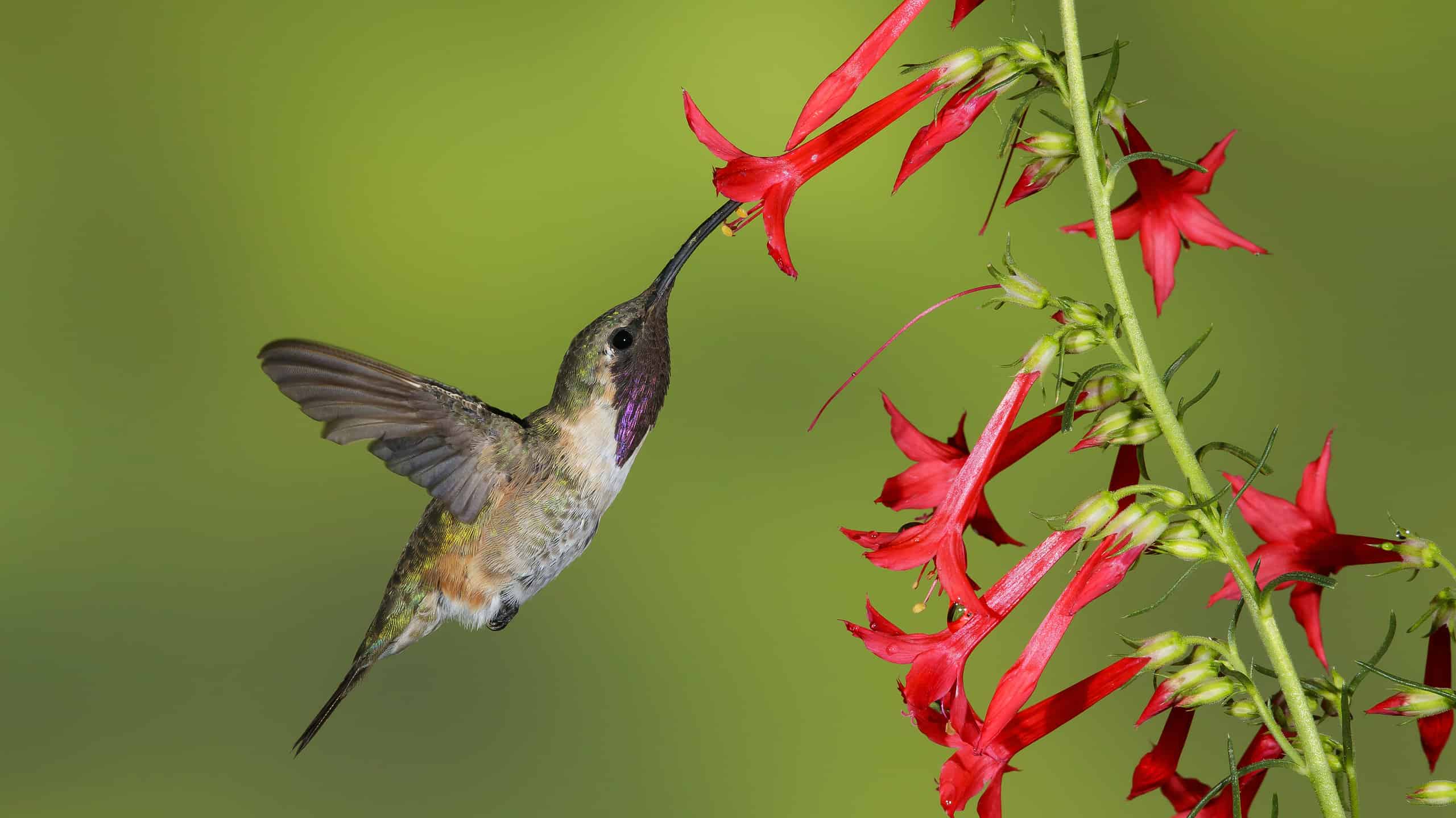Texas is chock-full of unique plants and animals that call the state home. Made up of at least 10 different ecoregions, Texas contains the ideal habitats for many different species. The state offers birdwatchers, in particular, a uniquely rich selection of feathered friends to track and enjoy, with over 600 species sighted and identified. Of those 600 birds, hummingbirds are one of the most recognizable — their jewel-bright colors dancing in the sun as they flit to and fro are hard to ignore and easy to see in your backyard.
Though there are as many as 27 different species of hummingbirds throughout the United States, only eight are common in Texas. Nine other species inhabit the state, but they’re rare. That makes for a total of 17 species passing through or nesting in the state.
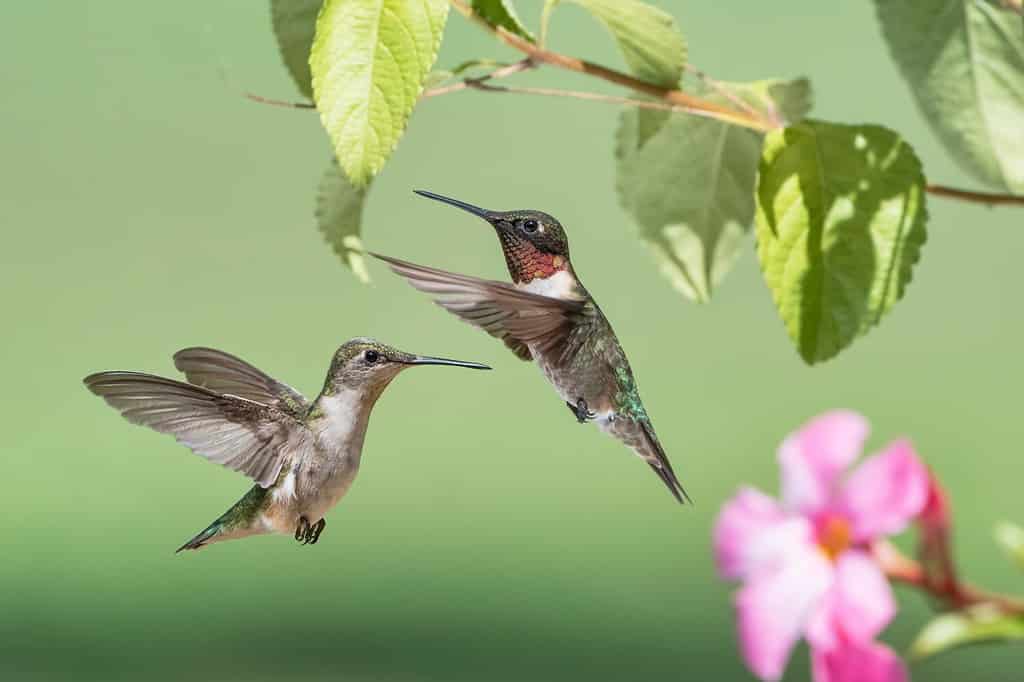
Male hummingbirds are more brightly colored than females.
©Bonnie Taylor Barry/Shutterstock.com
The Common Hummingbird Species in Texas
- Black-chinned hummingbird
- Ruby-throated hummingbird
- Rufous hummingbird
- Calliope hummingbird
- Broad-tailed hummingbird
- Buff-bellied hummingbird
- Blue-throated mountain gem
- Lucifer hummingbird
Black-Chinned Hummingbird
The black-chinned hummingbird is the most common and abundant species within the state of Texas. These green and purple beauties arrive in March and make their nests throughout the state. By the time late August rolls around, most adult hummingbirds have migrated south — but the young hummers born each spring can hang around until early fall, leaving by the end of September when they’re strong enough. However, they can potentially be found year-round in a specific area in southern Texas near Corpus Christi.

Black-chinned hummingbirds’ dark feathers look black until the sun hits and reveal bright purple instead.
©rck_953/Shutterstock.com
Ruby-throated Hummingbird
Though ruby-throated hummers are a common sight throughout the state, it’s only on their way somewhere else. Ruby-throated hummingbirds primarily nest and spend their summers in northeastern states and Canada. They pass through eastern and central Texas on their way to these northern sites though, typically between March and August.
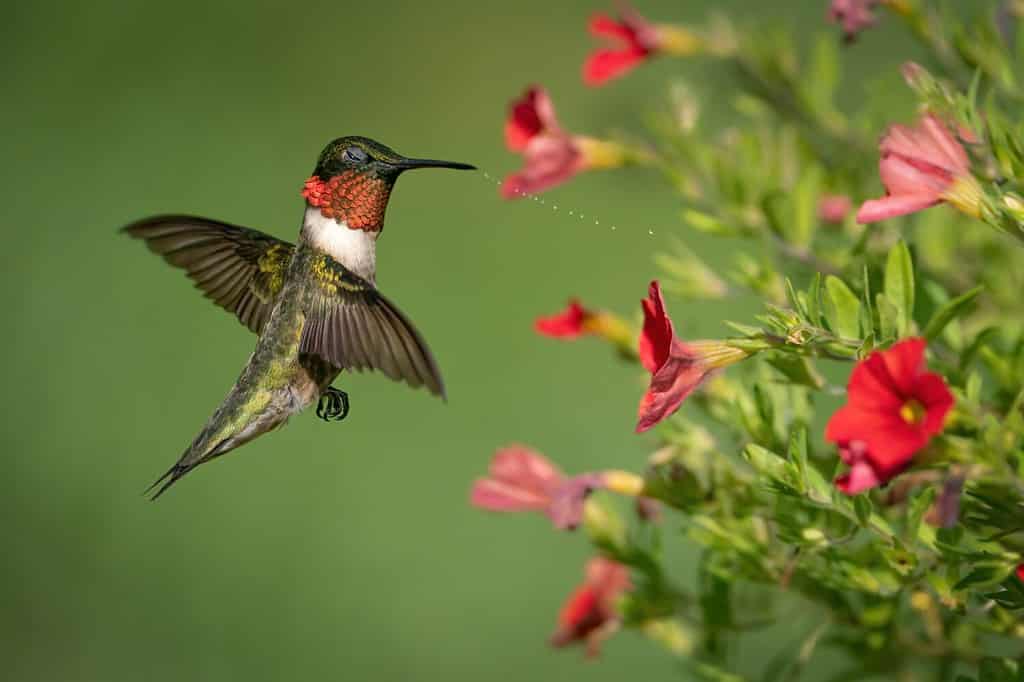
A ruby-throated hummingbird enjoys some fresh nectar.
©Cavan-Images/Shutterstock.com
Rufous Hummingbird
Rufous hummingbirds flash striking orange, red, and copper feathers. Though they’re on the small side for an already-small class of bird, rufous are some of the most aggressive hummers and can be fiercely territorial of hanging feeders and other food sources. Some on the Gulf Coast may see the rufous, but they’re seen most commonly in western Texas cities as they head as far north as Alaska to breed.

Male rufous hummingbirds exhibit a brightly colored, reddish-orange face.
©Keneva Photography/Shutterstock.com
Of the remaining types of hummingbirds common in Texas, most are simply passing through and may grace your garden or hanging feeder with their beautiful colors for a short while. Some, like the broad-tailed, blue-throated mountain gem and Lucifer hummingbirds, have breeding sites in Big Bend National Park and can be seen throughout the western part of the state.
Destination: Where Do Texas’ Hummingbirds Go?
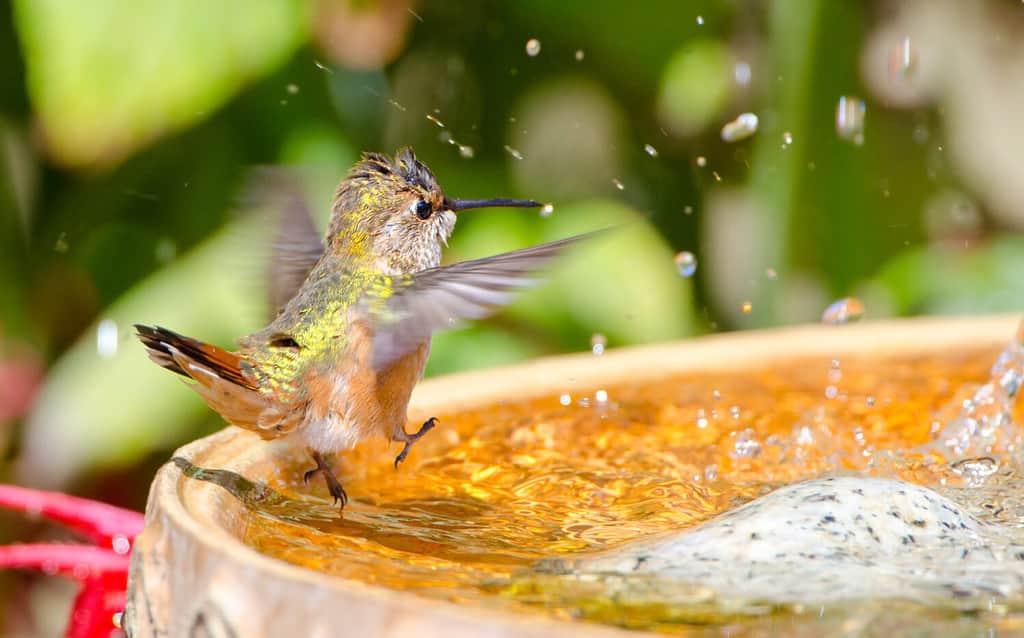
Hummingbirds often take breaks during their migration for food, water, and rest.
©Birdiegal/Shutterstock.com
Due to their small size and lightning-fast metabolism, most hummingbird species can’t survive weather that’s too hot or too cold. Their solution: follow the food! Hummingbirds instinctively travel north just as spring arrives, bringing flowers to bloom and bugs out to play. In the time it takes them to reach their preferred breeding grounds, even as far north as Alaska and Canada, spring will have sprung, and there will be plenty for the hummers to eat. Each hummingbird species has its own preferred area. Some like northern coastal regions like the Pacific Northwest or the New England Coast, some like mountains, and some are perfectly content staying in Texas.
In the fall, the reverse happens. As northern climates get colder and food becomes scarcer, hummingbirds travel south to maintain their diets. But even Texas winters bring temperatures too low for most of their little bodies to withstand. Nearly all migratory species spend the winter in warmer, more tropical climates, primarily Mexico or Central America, where flowers, insects, and other diet staples are still plentiful.
Nearly all hummingbirds favor the ‘over land’ approach and follow migration routes that provide opportunities for mid-journey snacks throughout Mexico. The ruby-throated hummingbird, on the other hand, takes a more direct (and exhausting) route over the Gulf of Mexico. These hummers make the non-stop, 500-mile journey twice a year and must time their migration carefully, as well as fatten up beforehand if they hope to survive. During their long-haul flight, ruby-throated hummingbirds can lose up to 60% of their pre-flight weight.
Winter Sightings
Not every species of hummingbird migrates — such as the Anna’s hummingbird, which tends to make year-round nests along the West Coast — or their migration pattern can be skewed farther north. Hummingbirds base their travel on where they were born, and some may choose coastal Texas as their winter destination. And, as mentioned above, some black-chinned hummingbirds may spend all year near Corpus Christi!
Rarer Species of Hummingbird in Texas
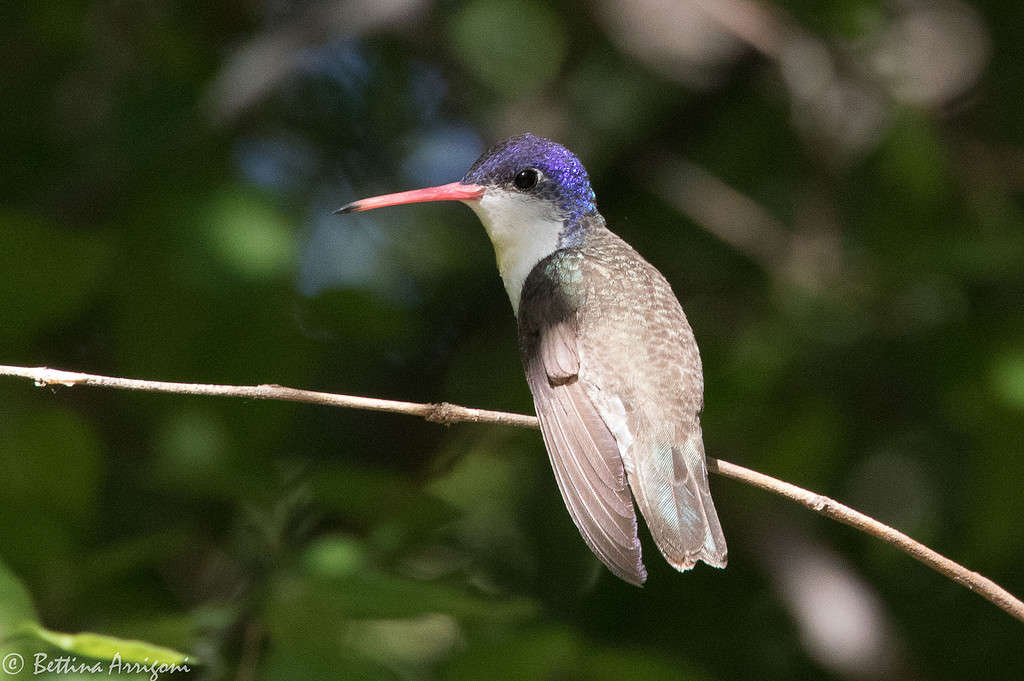
A violet-crowned hummingbird’s flashy feathers are on its head rather than its throat.
These species either have migratory or nesting sites nearby and have wandered through Texas or have only been seen a handful of documented times.
- Anna’s hummingbird
- Broad-billed hummingbird
- Magnificent hummingbird
- Allen’s hummingbird
- White-eared hummingbird
- Mexican violetear (aka green violetear)
- Violet-crowned hummingbird
- Berylline hummingbird
- Green-breasted hummingbird
If you’re lucky enough to see one, make sure you enjoy the rare moment!
How to Attract Hummingbirds
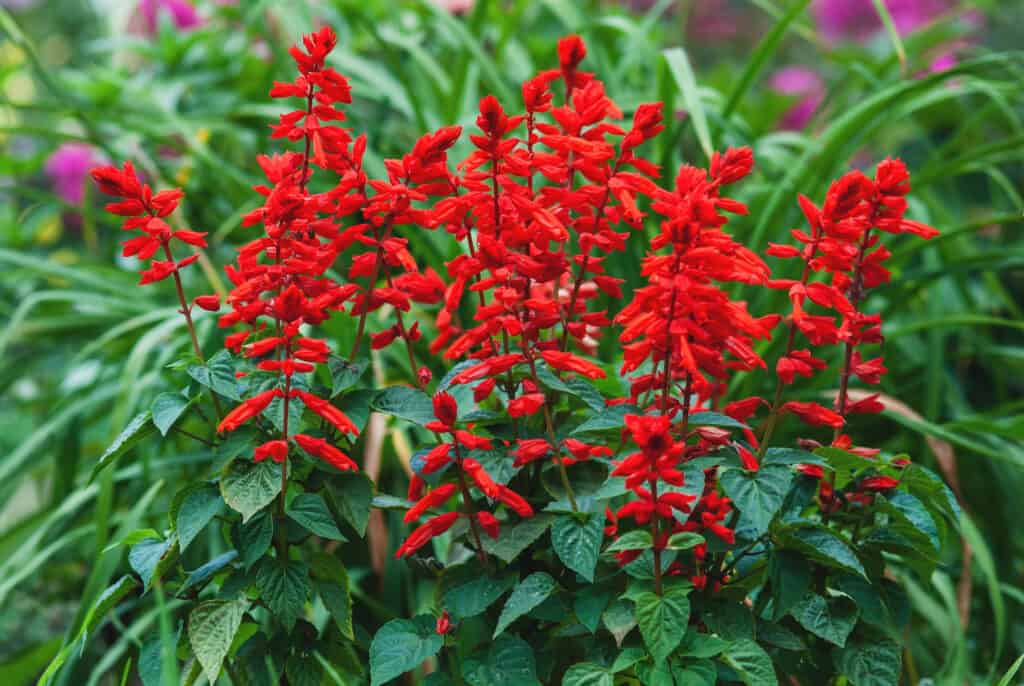
Scarlet sage salvia produces vibrant red flowers that both hummingbirds and butterflies enjoy.
©iStock.com/Nadya So
Hummingbirds eat both insects and nectar, and in fact, they need both to maintain a healthy diet. The sugar-water hanging feeders make a decent substitute, but there are more natural ways to bring the dazzling little birds to your Texas backyard. Hummingbirds particularly love tube-shaped flowers, which tend to produce the most nectar. Here are some options native to Texas that are both beautiful and delicious for these winged pollinators.
- Hummingbird bush
- Salvia
- Trumpet vine
- Cuphea varieties
- Butterfly weed (aka milkweed)
- Lantana
- Coral honeysuckle
Thank you for reading! Have some feedback for us? Contact the AZ Animals editorial team.

